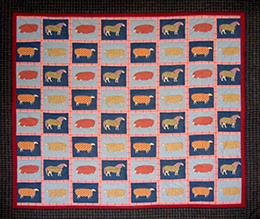How to Repair a Damaged Quilt
Traditionally, quilts were made to be used as part of day-to-day family life and were rarely created solely for show purposes. As with anything that is used regularly, even the most ruggedly built quilt will eventually show signs of wear.
With quilts in regular daily use it is not uncommon to find over a long period of time sections where the seams may have frayed, colors may have stained or faded, the fabric may have worn thin or even worn all the way through to reveal the batting inside!
The best time to consider repairing a quilt is as soon as the first signs of wear are visible. To keep using a quilt while it is in a damaged state will make its condition worse, and you run the risk of ruining the quilt entirely and leaving it beyond repair!
Be prepared for repairs!
Given that most quilts will eventually require repair at some stage (especially if they are being used by children!) there are a couple of things you can do to make the repair process easier.
If you make your own quilts then it can be a good idea to put aside a little bit extra of the fabric and thread that you used in each quilt. Keep it somewhere where you know it will be safe and when it is time to make a repair you can save a lot of hassle trying to find matching material which may have since been discontinued.
Quilts that were bought or that you no longer have any of the original fabrics or threads left can be harder to repair. In this case it may be worth taking the quilt with you to a number of fabric shops to try and find the best match for the color and pattern.
Remember when trying to match the fabric for a repair that as a quilt ages its color may fade or change. Sunlight tends to lighten the color of the fabric and make it go pale over time, especially with reds. Dust and dirt also tends to discolor white fabrics over the years, even if the quilt is kept clean.
Find a repair and restoration expert
When repairing a quilt you need to be extremely careful. As fabric manufacture methods and fashions change it can be extremely hard to find modern fabrics that match the original textiles. A bad repair or restoration effort may not only look awful, but can seriously affect the value of the quilt!
For valuable vintage or antique quilts in particular, and if you are at all uncertain, it is essential to employ the skills of a trained and experienced quilt repair and restoration expert. Many museums will have or know someone specialising in textile conservation. Likewise, specialty antique dealers and auction houses may sometimes be able to recommend someone.
While the cost of getting a professional to repair your quilt may sometimes at first seem expensive, when you consider how many more years of life it will bring to your quilt, it is usually worth it for the piece of mind that the repair will be done correctly.

